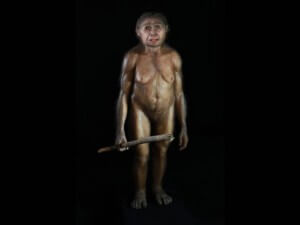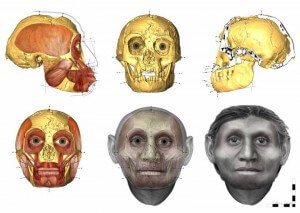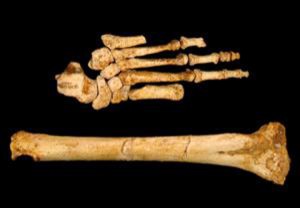 1
1

Arkaim and the texts of Rgveda about his builders
 25. 04. 2024
25. 04. 2024



 1
1
 29. 01. 2024
29. 01. 2024

The dwarves who inhabited the Indonesian island of Flores about 15 thousands of years ago, Homo sapiens, do not like relatives.
Long history, almost a saga, continues. It is associated with the sensational discovery of paleontologists from the Australian University in New England (New South Wales). In 2003, skeletal remains of eight small, human-like creatures were found in the Liang Bua Cave on the Indonesian island of Flores (near the popular tourist island of Bali). These were adults moving upright, up to one meter tall and weighing about 25 kilograms.
Among the findings was a well-preserved female skull the size of a grapefruit and other parts of the skeleton. In scientific circles, they christened its user and relatives to hobbits, according to a similar nation in the famous book The Lord of the Rings. The official name of the species is Homo floresiensis (Flores Man).
Anthropologists are debating whether the hobbits, these Homo floresiensis, are our ancestors or whether they belong to another small species of people who once lived on our planet. Or are they normal prehistoric people suffering from a disease that did not allow them to grow up? For example, microcephaly, a disease in which the brain remains small and underdeveloped.
Recently, Antoine Balzeau of the National Museum of Natural History in Paris, together with paleontologist Philippe Charlier of the University of Paris Descartes, re-examined the skull of the hobbit, carefully  studied the tissues in high resolution and found no characteristics linking Homo floresiensis with Homo sapiens. Researchers have not found traces of genetic diseases that would lead to pathological small stature. So, in Balzeau and Charlie's opinion, hobbits are not humans, but neither are monsters. So who are they?
studied the tissues in high resolution and found no characteristics linking Homo floresiensis with Homo sapiens. Researchers have not found traces of genetic diseases that would lead to pathological small stature. So, in Balzeau and Charlie's opinion, hobbits are not humans, but neither are monsters. So who are they?
According to current researchers, the "halflings" are descendants of Homo Erectus, who have become extremely smaller during the inhabitation of the island. This sometimes happens when a species finds itself in isolation, such as dwarf hippos, once long ago normally large.
Some time ago, British colleagues of French paleontologists compared the brains of normal and dwarf hippos. At the same time, they found that the reduction occurred in roughly the same proportion as the hobbits. In other words, the reduction could indeed have occurred during natural evolution. But British scientists assumed that the ancestor of the hobbits was Homo habilis.
Balzeau and Charlie did not rule out another option: the hobbit could still be an unknown kind of human being.
Otherwise, even before the French, scientists from the University of Washington's medical school defended the hobbits against the accusation of disfigurement. They created a computer model of a grapefruit-sized head and determined the characteristics of the brain based on the prints on the skull bones. In their opinion, the development was completely normal.
Anthropology professor Dean Falk of Florida State University compared the same skull with the skulls of nine people suffering from microcephaly and found no match. She concluded that the hobbit woman certainly did not have a damaged brain and was not ill.
The hobbit woman showed her face
Not so long ago, dwarf people from the island of Flores only appeared approximately, because we didn't have a more accurate portrait, now we have it. Using the method of Russian Professor Gerasim, Dr. Susan Hayes of the University of Woollongong reconstructed the appearance of a hobbit woman. And her face was presented by the doctor at the Australian Archaeological Conference.
Mrs. Hayes noted that the thirty-year-old representative of the weak sex hobbits did not, at least in our view, distinguished herself. She had dislocated cheekbones and large, upright ears. But she was not like a monkey.
BY THE WAY
It's not feet but some skis
 Paleoanthropologist William Jungers of the University of New York (Stony Brook University in New York) put forward further arguments in favor of the version that hobbits are a separate species. The scientist looked at the feet of these creatures and admitted that he had never seen anything like it.
Paleoanthropologist William Jungers of the University of New York (Stony Brook University in New York) put forward further arguments in favor of the version that hobbits are a separate species. The scientist looked at the feet of these creatures and admitted that he had never seen anything like it.
Homo floresiensis have incredibly large feet, they are larger than half a shin, about 25 centimeters. For someone who is up to one meter tall, it's too much. Sure, they're not skis, but they're just as respectable as Frodo's The Lord of the Rings and other hobbits known from movies whose creators endowed them with large, hairy feet.
Jungers suppose that the half-masters were forced to raise their legs so that they would not roam the ground.
In addition, they had significantly flat legs and a short thumb. These were characteristics that, according to scientists, allowed them to move quickly and quietly.
AND AT THE TIME
Hobbits, are not you the little ones?
An analysis of the remains discovered in the caves of Flores Island showed that the hobbits, who lived on the island 12-18 thousand years ago, used stone tools and knew fire. But at that time, the island was also inhabited by "normal" people. So two different species existed at the same time?
Apparently it was. And it is not by itself that the native islanders have legends about some hairy dwarfs living in caves. To this day, they call them Ebu Gogo and claim that the hairy creatures went to the jungle. But they have not disappeared, there are documents that show that Ebu Gogo met Dutch merchants in the XNUMXth century.
French biologist Bernard Heuvelmans published a book in 1959 telling the species of dwarfs that inhabited the problematic islands of Indonesia, says Andrej Perepelicin, head of  Labyrinth exploration group. Heuvelmans was scorned at the time, and now there was evidence that he was right.
Labyrinth exploration group. Heuvelmans was scorned at the time, and now there was evidence that he was right.
Some cryptozoologists do not rule out that Ebo Gogo could be a special kind of yetti, bushy and wild. Unlike the mighty Snowman, Bigfoot, and other relict hominids, the hobbits are tiny.
Snowman hunters believe that the species may have shrunk and recall the existence of a dwarf elephant, whose remains were also found on the island of Flores - the size of which was equal to the size of a grazed bull.
Interestingly, after scientists noticed large feet in hobbits and admitted, as another after cryptozoologists, that Homo floresiensis could indeed shrink, the new species was also called bigfoot - an analogy called a snowman in the United States. Even the scientific journal New Scientist used the word bigfoot in its article on hobbits.